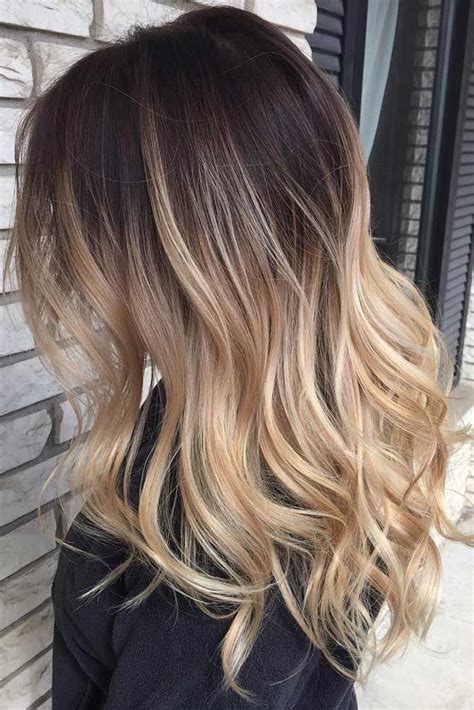Introduction
Ombre hair color, a captivating technique that seamlessly blends multiple shades, has become a global phenomenon, adorning the tresses of countless fashion enthusiasts and celebrities alike. This versatile style offers endless possibilities for expressing individuality, with a range of color combinations and transition effects to cater to every taste. In this comprehensive guide, we delve into the world of hair ombre color, exploring its origins, techniques, benefits, and popular variations.

Origins of Ombre Hair Color
The roots of ombre hair color can be traced back to the early 2010s, when the trend emerged as a gradual color transition from dark roots to lighter ends. Inspired by the sun-kissed hair of beachgoers, it quickly gained popularity on runways and red carpets, capturing the attention of hair enthusiasts worldwide.
Techniques for Creating Ombre Hair Color
Achieving a flawless ombre look requires expertise and meticulous application. Several techniques are commonly employed:
-
Traditional Ombre: A gradual transition from darker roots to lighter ends, using a single base color and a complementary highlight shade.
-
Reverse Ombre: A variation where the hair is lightest at the roots and gradually darkens towards the ends.
-
Multidimensional Ombre: Involves using multiple shades to create a more complex and dynamic transition.
-
Balayage Ombre: A freehand painting technique that creates soft, natural-looking highlights.
Benefits of Ombre Hair Color
-
Enhances Natural Beauty: Ombre hair color complements various hair textures, enhancing natural highlights and creating the illusion of depth and movement.
-
Low Maintenance: Unlike traditional highlights, ombre hair color requires less frequent touch-ups, as the root growth blends seamlessly with the lighter ends.
-
Versatile Styling: Ombre hair color can be adapted to suit any face shape and hair length, offering endless styling possibilities.
Popular Ombre Hair Color Variations
The versatility of ombre hair color allows for a myriad of variations:
-
Bronde Ombre: A blend of brown and blonde shades, creating a warm and natural look.
-
Platinum Ombre: A striking combination of dark roots with platinum blonde ends.
-
Copper Ombre: A vibrant transition from dark roots to copper or auburn shades.
-
Caramel Ombre: A warm and flattering option that combines rich brown roots with caramel highlights.
-
Gray Ombre: A trendy and edgy combination of dark roots with gray or silver ends.
DIY vs. Professional Ombre Hair Coloring
While it’s tempting to attempt ombre hair color at home, it’s highly recommended to seek professional assistance. Experienced stylists can assess your hair type and condition, ensuring a flawless application and avoiding potential damage from incorrect techniques.
Common Mistakes to Avoid
-
Overlapping Colors: Blending the colors too much can create an unnatural or muddy look.
-
Uneven Application: Inconsistent application can result in visible lines or patches.
-
Harsh Transitions: A sudden transition between colors can be unflattering and detract from the overall effect.
-
Wrong Color Choice: Choosing shades that don’t complement your skin tone or hair texture can lead to a disappointing outcome.
FAQs
-
How long does ombre hair color last? With proper care, ombre hair color can last up to six months.
-
Can I bleach my hair before doing ombre? Yes, but it’s essential to condition your hair thoroughly to avoid damage.
-
How often should I get an ombre touch-up? Every 8-12 weeks, depending on the hair growth rate.
-
Is ombre hair color suitable for all hair types? Yes, but it’s advisable to consult a stylist to determine the best variation for your hair.
-
Can ombre hair color damage my hair? Proper application and maintenance can minimize damage.
-
How can I maintain ombre hair color? Use color-protecting shampoos and conditioners, avoid heat styling, and get regular trims to remove split ends.
-
What’s the difference between ombre and balayage? Balayage is a freehand technique that creates softer, more natural-looking highlights. Ombre, on the other hand, involves a more structured transition.
-
Can I use box dye to create ombre hair? No, it’s highly recommended to use professional hair color products and seek assistance from a stylist.
Conclusion
Ombre hair color is a versatile and flattering technique that has captured the hearts of hair enthusiasts worldwide. With its endless variations and customizable options, there’s an ombre style perfect for everyone. By understanding the techniques, benefits, and common mistakes to avoid, you can achieve a stunning ombre look that will elevate your personal style and leave a lasting impression.
